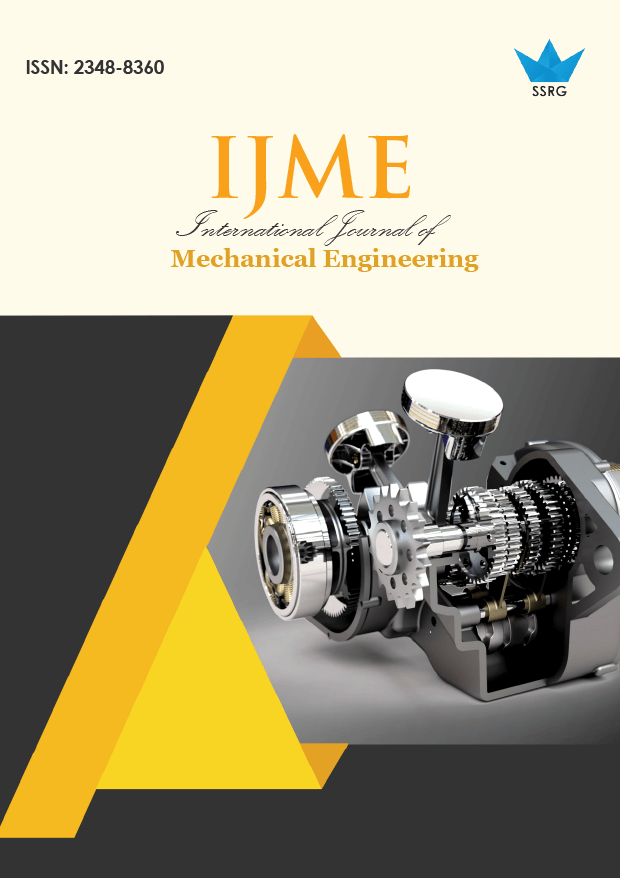Design and Analysis of a Cross-Plane Solenoid Engine for Torque Ripple Stability in Electric Vehicles

| International Journal of Mechanical Engineering |
| © 2025 by SSRG - IJME Journal |
| Volume 12 Issue 8 |
| Year of Publication : 2025 |
| Authors : Lee Eunjune, Kim Eunseo, Kim Sunjae, Kim Gyeonmin |
How to Cite?
Lee Eunjune, Kim Eunseo, Kim Sunjae, Kim Gyeonmin, "Design and Analysis of a Cross-Plane Solenoid Engine for Torque Ripple Stability in Electric Vehicles," SSRG International Journal of Mechanical Engineering, vol. 12, no. 8, pp. 12-19, 2025. Crossref, https://doi.org/10.14445/23488360/IJME-V12I8P102
Abstract:
The Internal Combustion (IC) engine is recognized as one of the major contributors to environmental pollution. Consequently, the demand for alternative fuels has been increasing due to the depletion of fossil fuel reserves and increasing environmental concerns. However, electric motors can cause instability at lower speeds, caused by torque ripples, which cannot be effectively resolved via the original motor structure. To tackle this problem, this paper proposes utilizing the boxer engine structure with a cross-plane crankshaft. To leverage this structural advantage of the IC engine, this study designs a solenoid-based engine, integrating the boxer engine composition and cross-plane crankshaft design. Since significant motion is not observed in the prototype engine. The present study, therefore, conducts a diagnosis of the engine’s failure to operate as intended, then gives a detailed analysis of the underlying causes and proposes potential solutions. Through numerical analysis, this study evaluates the efficiency of the refined engine.
Keywords:
Electric engines, Electromagnetic forces, Electromagnetic inductions, Engine stabilities, Motors.
References:
[1] Simone Franzò, and Alessio Nasca, “The Environmental Impact of Electric Vehicles: A Novel Life Cycle-Based Evaluation Framework and its Applications to Multi-Country Scenarios,” Journal of Cleaner Production, vol. 315, 2021.
[CrossRef] [Google Scholar] [Publisher Link]
[2] Jihyeok Jung et al., “Factors Affecting Consumers’ Preferences for Electric Vehicle: A Korean Case,” Research in Transportation Business & Management, vol. 41, 2021.
[CrossRef] [Google Scholar] [Publisher Link]
[3] Anamika Tiwari et al., “Design and Fabrication of 4-Stroke Solenoid Engine,” International Research Journal of Engineering and Technology, vol. 6, no. 12, pp. 2819-2825, 2019.
[Google Scholar] [Publisher Link]
[4] Shirsendu Das, “An Electromagnetic Mechanism Which Works Like an Engine,” International Journal of Engineering Trends and Technology, vol. 4, no. 6, pp. 2376-2379, 2013.
[Google Scholar] [Publisher Link]
[5] Ejazmallik Ansari et al., “Design and Fabrication of Single Cylinder Solenoid Engine,” Anveshana’s International Journal of Research in Engineering and Applied Sciences, vol. 7, no. 2, pp. 1-11, 2022.
[Google Scholar] [Publisher Link]
[6] Piyush Hota, Mahima Rathore, and Danish Shaikh, “Magnetic Repulsion Piston Engine,” International Journal of Science and Research, vol. 4, no. 12, pp. 338-344, 2015.
[Google Scholar] [Publisher Link]
[7] Navdeep Singh et al., “RPM Variable Solenoid Engine,” Mediterranean Journal of Basic and Applied Sciences, vol. 5, no. 4, pp. 1-12, 2021.
[CrossRef] [Google Scholar] [Publisher Link]
[8] Yannik Louvigny, and Pierre Duysinx, “Advanced Engine Dynamics Using MBS: Application to Twin-Cylinder Boxer Engines,” IMSD 2010 (The 1st Joint International Conference on Multibody System Dynamics), Lappeenranta, Finland, pp. 1-10, 2010.[Google Scholar] [Publisher Link]

 10.14445/23488360/IJME-V12I8P102
10.14445/23488360/IJME-V12I8P102